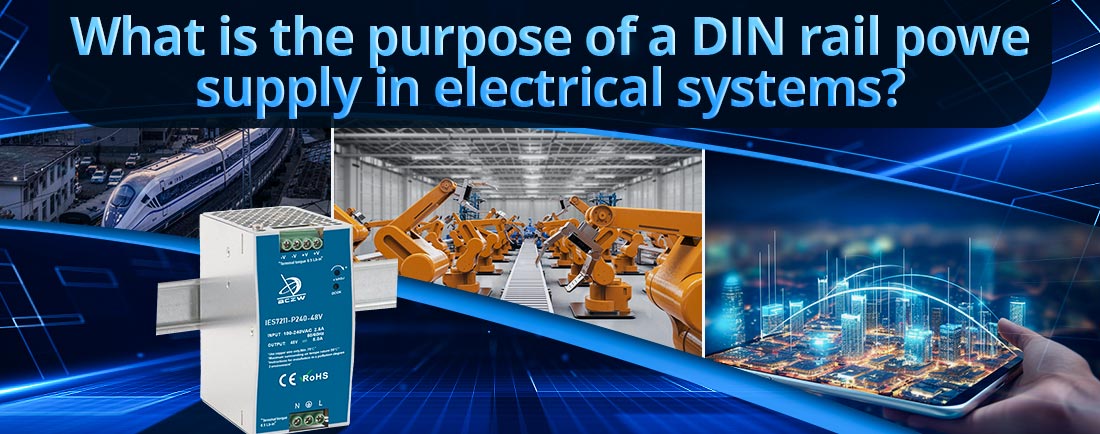
Una fuente de alimentación de riel DIN sirve como componente crítico en los sistemas eléctricos, ya que proporciona energía estable y regulada a dispositivos y equipos montados dentro de un gabinete o panel de control. Diseñadas para su instalación en rieles DIN (rieles metálicos estandarizados), estas fuentes de alimentación se utilizan ampliamente en aplicaciones industriales, comerciales y residenciales. A continuación se muestra una explicación detallada de su propósito y funcionalidad:
Propósito de una fuente de alimentación de riel DIN
1. Conversión y regulación de energía
El propósito principal de un Fuente de alimentación en carril DIN es convertir la energía eléctrica entrante en una salida de CC regulada adecuada para alimentar dispositivos electrónicos sensibles. Esto incluye:
--- Conversión de CA a CC: Convierte la corriente alterna (CA) de la red eléctrica en corriente continua (CC), que es requerida por la mayoría de los dispositivos industriales y de control.
--- Regulación de voltaje: Garantiza un voltaje de salida estable (por ejemplo, 12 V, 24 V o 48 V CC), incluso con fluctuaciones en el voltaje de entrada o condiciones de carga variables. La energía estable es fundamental para prevenir fallos de funcionamiento y garantizar un funcionamiento fiable.
2. Integración simplificada del sistema
Las fuentes de alimentación en carril DIN están diseñadas específicamente para sistemas modulares. Su tamaño compacto y método de montaje estandarizado facilitan su integración junto con otros componentes montados en riel DIN, como:
--- PLC (Controladores Lógicos Programables)
--- HMI (Interfaces Hombre-Máquina)
--- Sensores y actuadores
--- Relés y contactores
--- Este enfoque modular agiliza el montaje de sistemas eléctricos y facilita el uso eficiente del espacio dentro de los paneles de control.
3. Distribución de energía
--- Las fuentes de alimentación de riel DIN a menudo actúan como fuente de alimentación central dentro de un gabinete, distribuyendo energía a múltiples dispositivos. Al proporcionar un suministro constante y centralizado, eliminan la necesidad de fuentes de alimentación independientes para cada dispositivo, lo que simplifica el diseño del sistema y reduce los costos.
4. Garantizar la confiabilidad en aplicaciones críticas
Los sistemas industriales y comerciales requieren fuentes de alimentación capaces de soportar condiciones duras. Las fuentes de alimentación en carril DIN están diseñadas para:
--- Opere de manera confiable en amplios rangos de temperatura.
--- Resiste vibraciones y golpes.
--- Manejar sobretensiones, transitorios e interferencias electromagnéticas (EMI).
--- Estas características garantizan un funcionamiento constante, incluso en entornos difíciles.
5. Eficiencia espacial y organización ordenada
--- Las fuentes de alimentación de riel DIN contribuyen a la disposición ordenada y organizada de los componentes eléctricos dentro de un gabinete. Al montarse directamente en un riel DIN, ahorran espacio y eliminan la necesidad de soportes personalizados o soluciones de montaje. Esto es especialmente beneficioso en paneles de control compactos donde el espacio es escaso.
6. Escalabilidad y flexibilidad
--- Las fuentes de alimentación en carril DIN respaldan la escalabilidad de los sistemas eléctricos. Se pueden agregar fácilmente fuentes de alimentación adicionales al mismo riel a medida que se expande el sistema. Su modularidad permite a los ingenieros adaptar la configuración del sistema sin un rediseño significativo.
7. Seguridad y Protección
Las fuentes de alimentación en carril DIN incluyen funciones de protección integradas para proteger tanto la fuente de alimentación como los dispositivos conectados:
--- Protección contra sobretensión: Evita que el exceso de tensión dañe los componentes.
--- Protección contra sobrecorriente: Limita la corriente durante cortocircuitos o condiciones de sobrecarga.
--- Protección Térmica: Apaga la fuente de alimentación si se sobrecalienta.
Aislamiento: Aísla eléctricamente la entrada de la salida, mejorando la seguridad y reduciendo el riesgo de daños por fallas.
Aplicaciones de las fuentes de alimentación para carril DIN
1. Automatización Industrial
--- Alimentación de PLC, sensores, actuadores y otros equipos de automatización en instalaciones de fabricación.
--- Utilizado en líneas de montaje, control de procesos y sistemas robóticos.
2. Sistemas de gestión de edificios (BMS)
--- Soporte para controladores HVAC, sistemas de iluminación y sistemas de seguridad en edificios inteligentes.
--- Energía centralizada para varios subsistemas dentro del edificio.
3. Telecomunicaciones
--- Suministro de energía a conmutadores de red, enrutadores y otros equipos de comunicación en centros de datos e infraestructura de telecomunicaciones.
4. Sistemas de energía renovable
--- Utilizado en inversores de paneles solares, sistemas de gestión de baterías y controladores de turbinas eólicas.
--- Alimentación de dispositivos de seguimiento y control en instalaciones de energías renovables.
5. Transporte
--- Montado en sistemas de señalización ferroviaria, sistemas de control de tráfico y sistemas de energía a bordo de vehículos.
6. IoT y computación perimetral
--- Proporcionar energía a dispositivos de IoT, puertas de enlace de computación de punta y sistemas distribuidos en proyectos de ciudades inteligentes o configuraciones de IoT industriales.
Ventajas de las fuentes de alimentación en carril DIN
1. Diseño compacto: optimizado para uso en espacios reducidos dentro de recintos.
2. Alta Eficiencia: Reduce las pérdidas de energía y la generación de calor, mejorando el rendimiento general del sistema.
3. Facilidad de instalación: El montaje a presión simplifica la instalación y el reemplazo.
4. Amplio rango de voltaje de entrada: se adapta a los estándares de energía globales (por ejemplo, 85–264 VCA o 12–48 VCC).
5. Durabilidad: Diseñado para soportar condiciones de grado industrial, incluidos amplios rangos de temperatura y tensiones mecánicas.
6. Rentable: reduce la necesidad de fuentes de alimentación individuales para cada dispositivo, lo que reduce los costos generales del sistema.
Conclusión
El propósito de una fuente de alimentación de carril DIN es garantizar una entrega de energía confiable y regulada en un formato compacto, modular y escalable. Al proporcionar una salida de CC estable y integrarse perfectamente con otros componentes montados en riel DIN, sirve como la columna vertebral de los sistemas eléctricos industriales y comerciales modernos. Con características de seguridad integradas y la capacidad de operar en entornos hostiles, las fuentes de alimentación de riel DIN son indispensables en aplicaciones de automatización, gestión de edificios, telecomunicaciones y energía renovable.